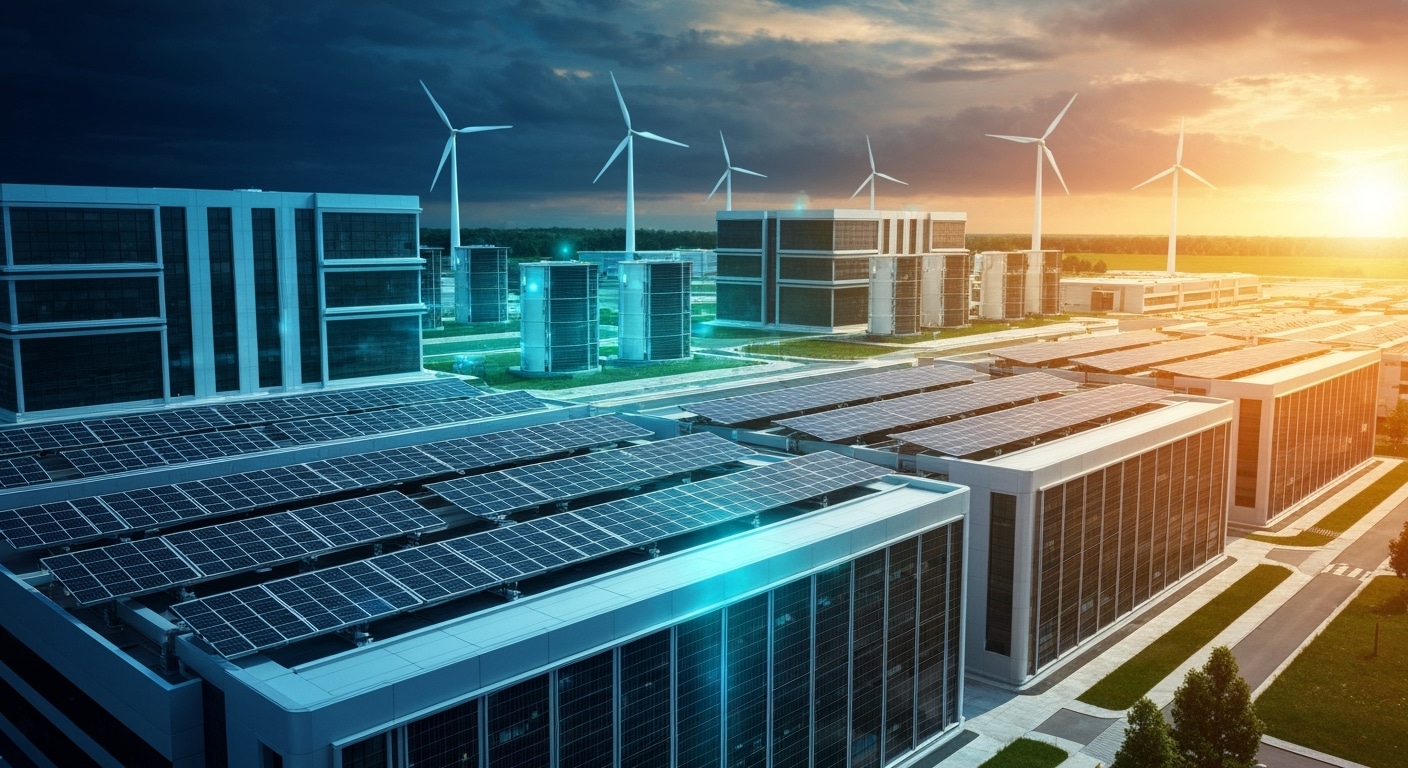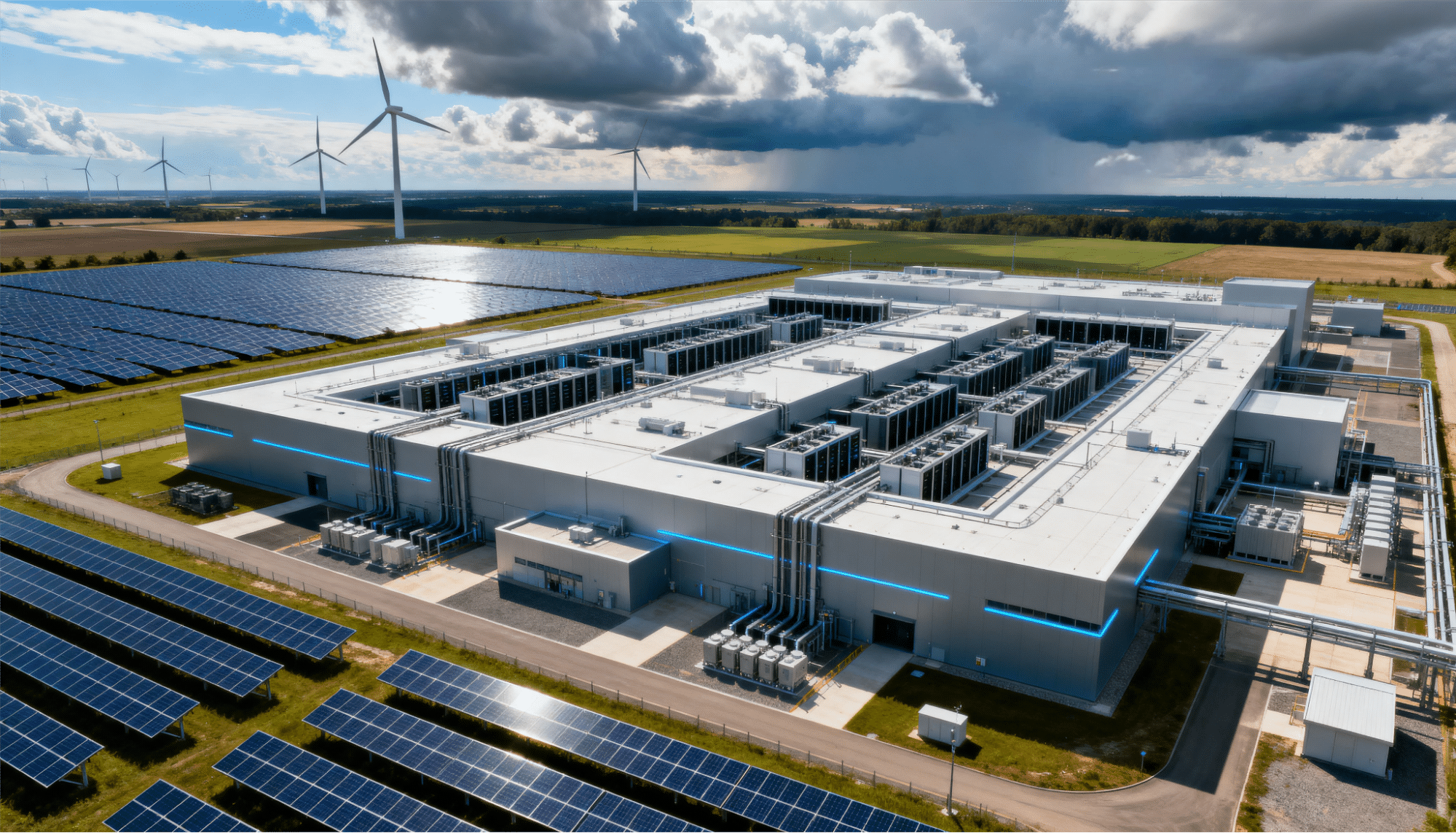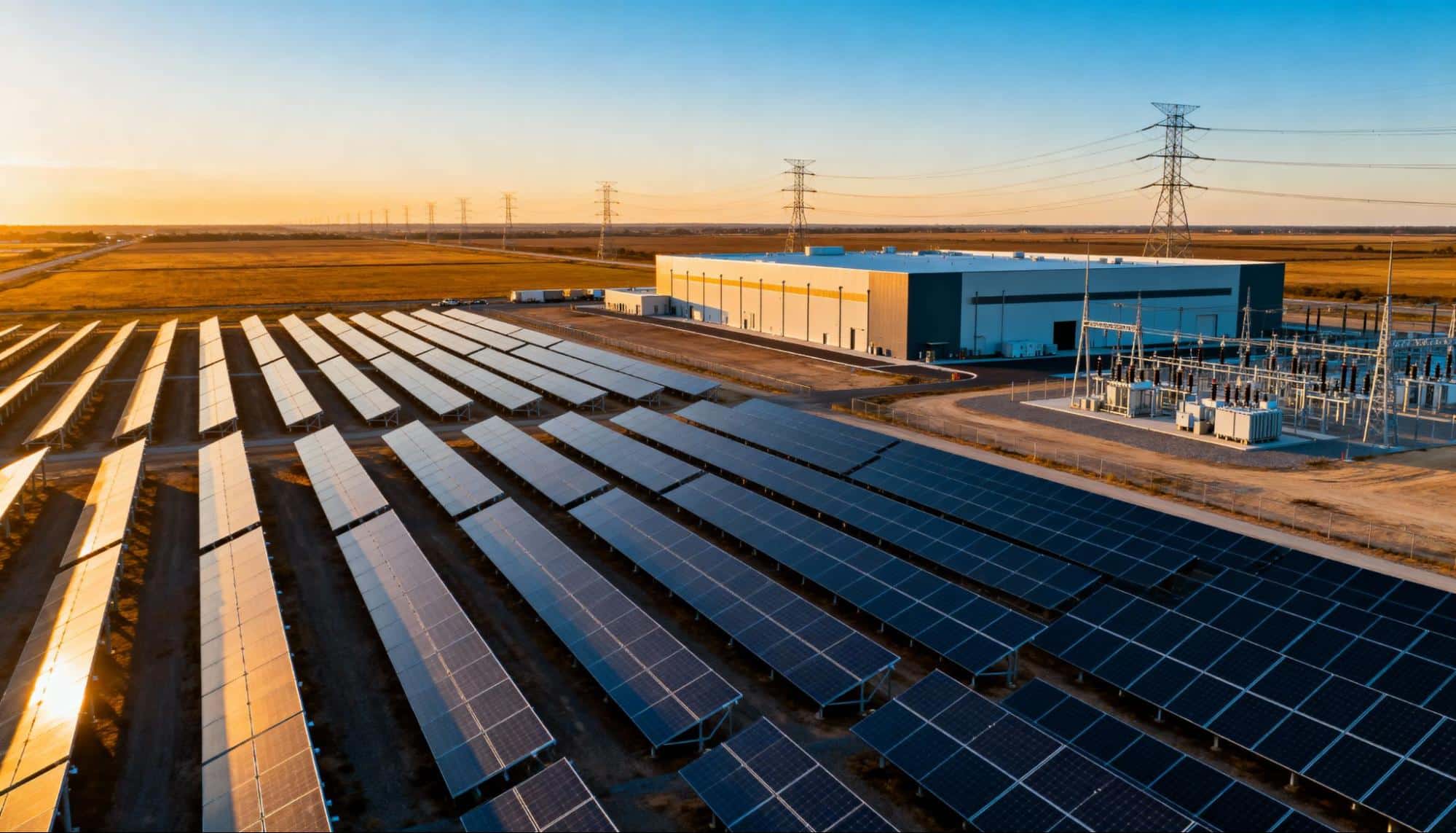Summary
Organizations without robust digital infrastructure solutions for business face a 93% chance of failure within one year of a major disruption.
- Power constraints and AI demands are reshaping infrastructure requirements, with data centers now consuming 4.4% of U.S. electricity
- ITIC’s 2024 research shows 90% of enterprises face downtime costs exceeding $300,000 per hour, making resilient infrastructure critical
- Data center electricity consumption doubled from 2017 to 2023, reaching 176 TWh, and could potentially triple again by 2028
- Investment in comprehensive business IT continuity planning has become a strategic necessity, not an operational consideration
The companies that treat infrastructure as a commodity risk operational paralysis—those that develop sophisticated digital infrastructure solutions for business continuity position themselves for sustained competitive advantage.
Nearly 93% of companies without a disaster recovery plan that suffer a major data disaster are out of business within one year. This isn’t a future risk—it’s today’s reality for organizations that haven’t adapted their infrastructure to handle the unprecedented demands of our AI-driven economy.
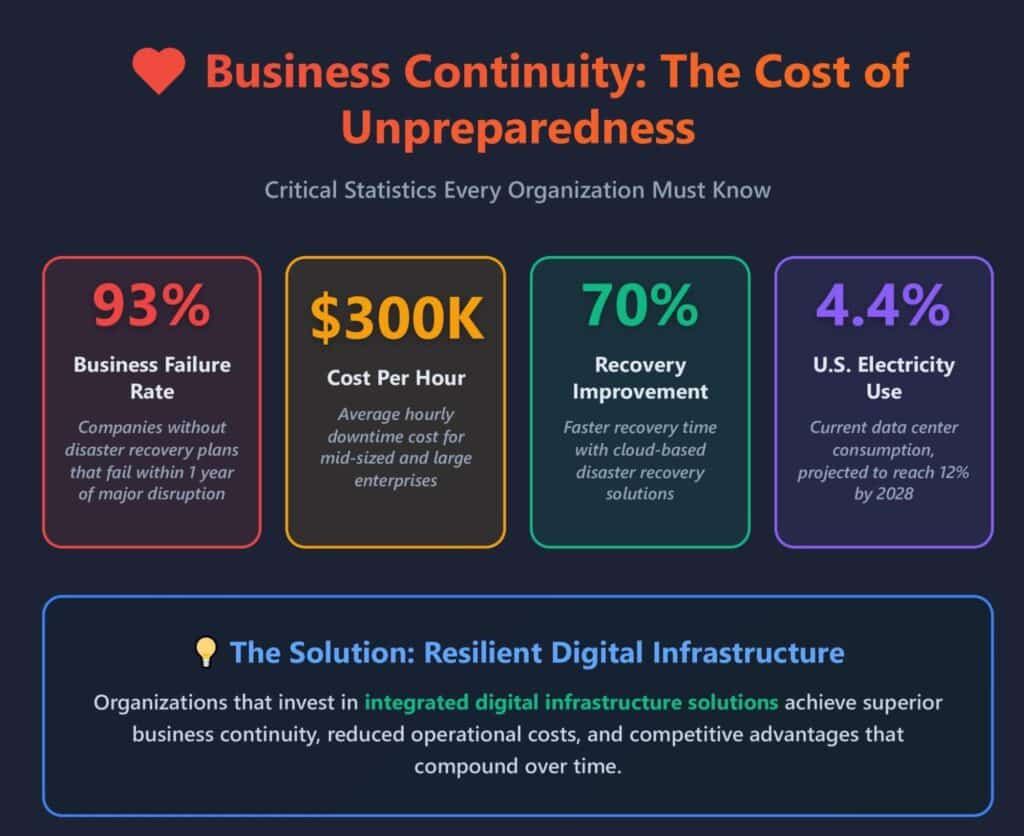
The traditional approach to digital infrastructure planning—reactive, compartmentalized, and grid-dependent—has become a liability. Modern AI workloads demand significantly more power than conventional computing, while ITIC’s 2024 research shows that 90% of mid-size and large enterprises now face downtime costs exceeding $300,000 per hour. Supply chain disruptions, extreme weather events, and regulatory changes continue to expose vulnerabilities in legacy infrastructure frameworks.
Digital infrastructure solutions for business continuity aren’t just about keeping the lights on anymore. They’re about creating adaptive, intelligent systems that anticipate disruptions, automatically redistribute resources, and maintain operations even when traditional support systems fail. Organizations that understand this shift are building competitive moats through infrastructure resilience.
What Are Digital Infrastructure Solutions for Business Continuity?
Digital infrastructure solutions for business encompass the integrated physical and virtual systems that ensure operational resilience during disruptions. These comprehensive solutions focus on more than traditional disaster recovery. Unlike traditional disaster recovery approaches that focus on restoring systems after failure, modern solutions prioritize prevention, prediction, and rapid adaptation to maintain continuous operations.
These solutions combine several critical components working in harmony. Power infrastructure forms the foundation, providing reliable, redundant energy sources that can handle both baseline operations and unexpected surge demands. Computing and storage systems must be distributed across multiple locations with real-time synchronization capabilities. Network infrastructure requires multiple pathways and automatic failover mechanisms to prevent single points of failure.
The AI revolution has fundamentally changed infrastructure requirements. According to the U.S. Department of Energy, data centers consumed about 4.4% of total U.S. electricity in 2023, rising from 58 TWh in 2014 to 176 TWh in 2023. Usage could potentially double or triple again by 2028. This exponential growth means organizations can no longer plan infrastructure reactively—they need integrated solutions designed for continuous expansion and adaptation.
Modern resilient digital infrastructure also incorporates predictive analytics and automation. Machine learning algorithms continuously monitor system performance, predict potential failures, and automatically adjust resource allocation to prevent disruptions before they occur. This proactive approach reduces incident response times from hours to minutes while minimizing human error.
Why Do Traditional Infrastructure Approaches Fall Short?
Traditional infrastructure planning approaches were designed for a different era of computing demands and threat landscapes. The fundamental assumptions underlying these legacy frameworks—stable power requirements, predictable growth patterns, and isolated system failures—no longer reflect operational reality.
Grid dependency represents perhaps the most critical vulnerability in traditional approaches. Most data centers rely entirely on utility grid power with backup generators for emergency situations. However, modern AI workloads require continuous high-power density that often exceeds local grid capacity. When Microsoft, Google, and Amazon struggle to secure adequate power for their data centers, the limitations of grid-dependent infrastructure become clear.
Siloed disaster recovery planning creates additional vulnerabilities. Traditional approaches treat IT systems, power systems, and facility management as separate domains with independent backup plans. During actual disruptions, these disconnected systems often fail to coordinate effectively, leading to cascading failures that compound initial problems.
The reactive nature of conventional planning also proves inadequate for modern threat environments. Traditional disaster recovery focuses on restoring systems after failures occur, but contemporary cyber threats, supply chain disruptions, and extreme weather events require proactive resilience measures. Organizations need infrastructure that adapts in real-time rather than waiting for manual intervention after problems arise.
Cost structures in traditional infrastructure planning often optimize for initial capital expenditure rather than total cost of ownership. This approach underestimates the true cost of downtime, which can be substantial. When factoring in these disruption costs, proactive infrastructure investment delivers significantly better ROI than reactive disaster recovery approaches.
What Are the Core Components of Resilient Digital Infrastructure?
Building truly resilient digital infrastructure requires orchestrating multiple technological systems into a cohesive, adaptive framework. Modern digital infrastructure solutions for business integrate energy, computing, network, and monitoring systems that work together seamlessly. Each component must function independently while contributing to overall system resilience through intelligent integration and automation.
Power and Energy Systems
Energy infrastructure forms the foundation of any resilient digital system. Traditional backup power systems—diesel generators and uninterruptible power supplies—provide temporary emergency power but can’t support the continuous high-density requirements of modern AI workloads. Resilient power infrastructure combines multiple energy sources including renewable generation, grid connections, and advanced storage systems.
Renewable energy integration offers both sustainability benefits and operational resilience. On-site solar and wind generation with battery storage can provide continuous power independent of grid constraints. Smart energy management systems automatically balance loads across multiple power sources while optimizing for both cost and reliability.

Computing and Storage Architecture
Distributed computing architecture prevents single points of failure while enabling automatic workload migration during disruptions. Edge computing brings processing closer to users, reducing latency and providing backup capacity when central systems experience problems. Hybrid cloud strategies combine on-premises control with cloud scalability and geographic distribution.
Storage systems must provide real-time data synchronization across multiple locations with automated failover capabilities. Modern storage solutions use software-defined architectures that can rapidly reconfigure based on performance requirements and availability constraints.
Network Infrastructure and Connectivity
Network resilience requires multiple connection pathways with intelligent routing capabilities. Software-defined networking enables automatic traffic redirection when primary connections fail, while maintaining performance standards across backup routes. Private networks provide additional security and control compared to public internet connections.
5G and edge connectivity enhance network resilience by providing diverse connection options and reducing dependency on centralized network infrastructure. These technologies enable distributed processing that can continue operating even when central facilities experience disruptions.
Monitoring and Analytics Systems
Continuous monitoring with predictive analytics transforms infrastructure from reactive to proactive. AI-powered monitoring systems analyze patterns across thousands of metrics to predict potential failures before they occur. Automated response systems can implement corrective measures immediately rather than waiting for human intervention.
Real-time performance dashboards provide operational visibility across all infrastructure components, enabling rapid decision-making during crisis situations. Integration with business continuity management platforms ensures that infrastructure alerts trigger appropriate organizational response procedures.
Which 7 Digital Infrastructure Solutions Are Essential for Business Continuity?
Organizations implementing digital infrastructure solutions for business need comprehensive approaches that address power, computing, networking, and management challenges. The following seven solutions represent the most critical components for maintaining operational resilience.
1. Integrated Renewable Energy Campus Development
Purpose-built energy campuses that combine solar, wind, and storage systems provide power independence while supporting sustainability goals. These integrated facilities can deliver gigawatt-scale power with built-in redundancy and expansion capability. Unlike traditional grid-dependent approaches, energy campuses can support continuous high-density AI workloads while maintaining competitive cost structures.
2. Edge Computing and Distributed Processing Networks
Edge computing infrastructure distributes processing across multiple geographic locations, reducing latency and providing automatic failover capabilities. When primary data centers experience disruptions, edge nodes can maintain critical operations while full systems recover. This distributed approach also improves performance for end users while reducing bandwidth requirements on central systems.
3. AI-Powered Predictive Infrastructure Management
Machine learning systems that continuously analyze infrastructure performance can predict equipment failures, optimize resource allocation, and automatically implement preventive measures. These systems improve overall system efficiency and transform infrastructure from a cost center into a strategic advantage. Predictive management enables proactive maintenance rather than reactive repairs.

4. Hybrid Cloud Architecture with Geographic Distribution
Hybrid cloud strategies combine on-premises control with cloud scalability and automatic geographic failover. Critical workloads can operate across multiple cloud regions with real-time data synchronization, ensuring continuous operations even during regional disruptions. This approach provides both performance optimization and disaster recovery capabilities.
5. Advanced Cooling and Power Distribution Systems
Next-generation cooling technologies including liquid cooling and immersion systems support high-density AI workloads while improving energy efficiency. Smart power distribution with automated load balancing prevents overload conditions while optimizing energy usage across multiple power sources. These systems enable infrastructure scaling without proportional increases in operational complexity.
6. Software-Defined Network Infrastructure
Software-defined networking with automatic failover capabilities provides network resilience and performance optimization. These systems can instantly redirect traffic during network disruptions while maintaining security and performance standards. Integration with security systems provides additional protection against cyber threats that could compromise network infrastructure.
7. Integrated Business Continuity Management Platforms
Unified platforms that coordinate infrastructure monitoring, incident response, and business continuity procedures ensure rapid, coordinated responses to disruptions. These systems integrate with all infrastructure components to provide comprehensive situational awareness and automated response capabilities. Advanced platforms use AI to optimize response procedures based on historical incident data and current conditions.
How Do You Implement Digital Infrastructure Solutions?
Successful implementation of resilient digital infrastructure requires a phased approach that balances immediate needs with long-term strategic objectives. The most effective digital infrastructure solutions for business combine tactical improvements with strategic transformation initiatives. Organizations should begin with comprehensive assessment of current vulnerabilities and future requirements rather than implementing isolated solutions.
Phase 1: Assessment and Strategy Development
Start with thorough analysis of current infrastructure capabilities, identifying single points of failure and capacity constraints. Business impact analysis should quantify the cost of different types of disruptions to prioritize investment areas. This assessment should include evaluation of energy requirements, computing demands, and network dependencies.
Strategic planning must account for future growth trajectories, particularly AI adoption plans that may dramatically increase power and cooling requirements. Organizations should model infrastructure needs under different growth scenarios to avoid costly retrofitting later.
Phase 2: Critical Infrastructure Hardening
Focus initial implementation on the most critical vulnerabilities identified during assessment. Power infrastructure typically requires the longest lead times, so energy planning should begin immediately. This may involve renewable energy development, grid upgrades, or energy storage implementation depending on specific requirements.
Network infrastructure improvements often provide immediate benefits with relatively quick implementation timelines. Software-defined networking and redundant connectivity can significantly improve resilience within weeks rather than months.
Phase 3: Automation and Intelligence Integration
Once basic infrastructure resilience is established, focus on implementing predictive analytics and automated response systems. These capabilities multiply the effectiveness of physical infrastructure investments by enabling proactive management and rapid response to emerging issues.
AI-powered monitoring systems should be integrated across all infrastructure components to provide unified visibility and coordinated response capabilities. Training and procedure development ensure that human teams can effectively leverage automated systems during crisis situations.
Phase 4: Continuous Optimization and Expansion
Infrastructure resilience requires ongoing refinement based on operational experience and changing requirements. Regular testing and updating of disaster recovery procedures ensures continued effectiveness as systems evolve. Performance metrics should track both system availability and business impact to guide future investment decisions.
Expansion planning should anticipate future technology adoption and regulatory changes that may affect infrastructure requirements. Scalable architectures implemented in earlier phases provide foundation for cost-effective expansion as needs grow.
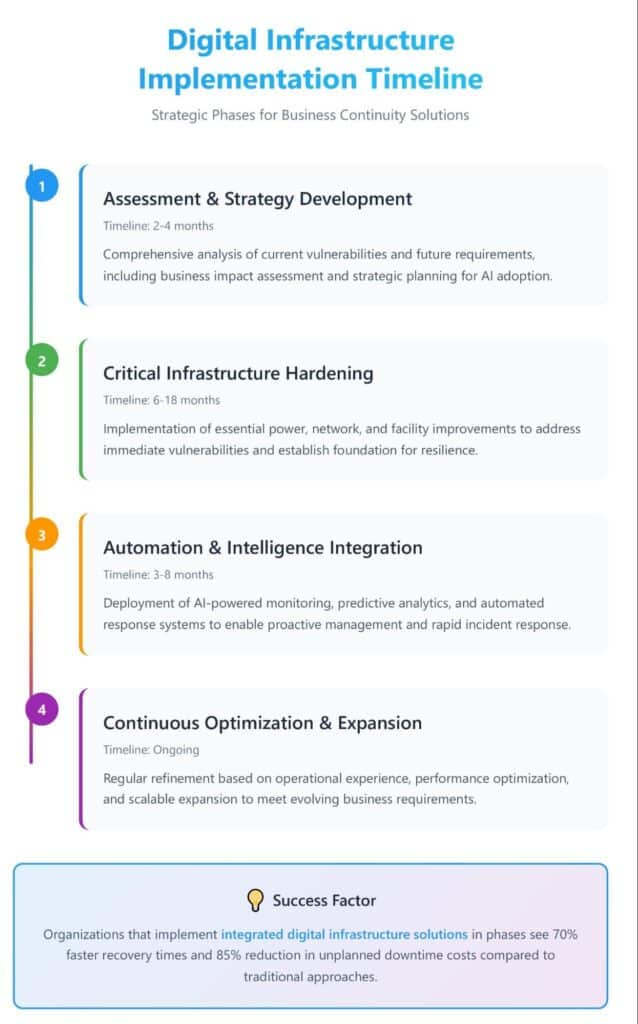
What Future Trends Will Shape AI, Sustainability, and Infrastructure Evolution?
The infrastructure landscape continues evolving rapidly, driven by advancing AI capabilities, sustainability requirements, and changing work patterns. Organizations building resilient infrastructure today must anticipate these trends to avoid costly retrofitting and ensure long-term competitiveness.
Artificial intelligence will increasingly shape both infrastructure requirements and management capabilities. AI workloads will continue demanding higher power densities and specialized cooling systems, while AI-powered management systems will provide more sophisticated optimization and predictive capabilities. The International Energy Agency projects that global electricity demand from data centers will more than double by 2030, with AI as the most significant driver of this increase.
Sustainability requirements are becoming both regulatory mandates and competitive necessities. Organizations will need to demonstrate measurable progress toward carbon neutrality while maintaining operational performance. Integrated renewable energy solutions provide the most effective path to meeting these dual requirements.
Edge computing adoption will accelerate as organizations seek to reduce latency and improve resilience through distributed architectures. 5G networks will enable new edge computing applications while providing additional connectivity options for improved network resilience.
Quantum computing may eventually reshape infrastructure requirements, though practical applications remain limited. Organizations should monitor quantum developments while focusing on conventional infrastructure optimization for current needs.
Regulatory frameworks will continue evolving to address AI safety, data privacy, and infrastructure security. Proactive compliance planning prevents costly retrofitting when new requirements are implemented.
How Do You Build Your Resilient Infrastructure Strategy?
The window for reactive infrastructure planning has closed. Organizations that continue treating infrastructure as a commodity rather than a strategic asset will find themselves increasingly constrained by capacity limitations and vulnerable to disruptions that competitors can navigate successfully.
Creating a scalable digital infrastructure plan requires balancing immediate operational needs with long-term strategic objectives. Start with comprehensive assessment of current vulnerabilities and future requirements, then prioritize investments based on business impact analysis and risk assessment.
The most successful infrastructure strategies integrate energy, computing, and network systems into cohesive frameworks rather than optimizing individual components in isolation. This integrated approach provides both operational efficiency and strategic flexibility as requirements evolve.
Frequently Asked Questions
How much does implementing resilient digital infrastructure cost compared to traditional approaches?
While initial capital investment for resilient infrastructure typically runs higher than traditional approaches, total cost of ownership is significantly lower when factoring in reduced downtime, improved efficiency, and avoided disruption costs.
What’s the typical timeline for implementing comprehensive digital infrastructure solutions?
Implementation timelines vary significantly depending on scope and complexity. However, many components can provide immediate benefits—network improvements and monitoring systems often show results quickly, while energy infrastructure and major construction projects require longer timelines.
How do you measure ROI on business continuity infrastructure investments?
ROI measurement should include direct cost savings from improved efficiency, reduced downtime costs, avoided disruption expenses, and competitive advantages from superior reliability. Organizations typically see accelerating returns as operational benefits compound over time.
Can smaller organizations implement these solutions or are they only for enterprises?
Scalable solutions are available for organizations of all sizes. Cloud-based and managed service options provide enterprise-level capabilities without requiring large capital investments. Many solutions can be implemented incrementally, allowing smaller organizations to build resilience over time.
How does AI change traditional disaster recovery planning?
AI transforms disaster recovery from reactive restoration to proactive prevention. Predictive analytics identify potential failures before they occur, while automated response systems implement corrective measures immediately. This shift reduces recovery time from hours to minutes while preventing many disruptions entirely.
Securing Your Digital Future Through Strategic Infrastructure
The organizations that thrive in the next decade will be those that recognize infrastructure as a strategic differentiator rather than a necessary cost. Digital infrastructure solutions for business provide the foundation for sustainable growth, operational resilience, and competitive advantage in an increasingly complex threat environment.
The choice isn’t between traditional and modern infrastructure approaches—traditional approaches are becoming obsolete whether organizations adapt or not. The choice is between proactive strategic planning and reactive crisis management, between integrated solutions and fragmented systems, between sustainable growth and operational constraints. Hanwha Data Centers brings together the integrated energy solutions, technical expertise, and financial strength needed to build truly resilient digital infrastructure. Our approach combines renewable energy development, strategic site selection, and purpose-built infrastructure to deliver the power-rich campuses that next-generation computing demands. Contact our team to explore how customized energy campus solutions can transform your digital infrastructure strategy.

